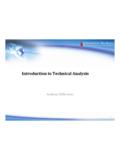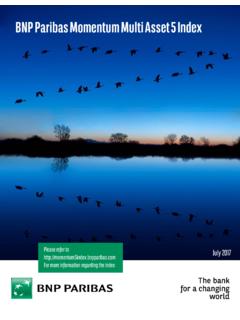Transcription of Variance swaps and CBOE S&P 500 variance futures
1 CHAPTER | EUROMONEY HANDBOOKS Variance swaps and cboe S&P 500 Variance futuresby Lewis Biscamp and Tim Weithers, Chicago Trading Company, LLCA long with the proliferation of the breadth and complexity of available volatility products has come increased anxiety and confusion about how investors can most effectively and efficiently trade volatility. We offer a brief overview of the concept of Variance and volatility; describe how a Variance swap can be used to trade equity-index volatility; and illustrate some advantages that Variance swaps offer over other volatility-based assets.
2 Lastly, we will describe how cboe Variance futures contracts are essentially the same as an OTC Variance swap. Volatility and varianceVolatility and Variance are measures of the level of variation of an asset s price over time. Even though volatility is the more commonly used term in the financial markets and media, an asset s volatility is actually derived from its Variance , as we will see below. An asset with high volatility is expected to move around more, in percentage terms, than a low-volatility single asset can also have a period of low volatility followed by a period of high volatility and vice-versa.
3 For example, the S&P 500 Index saw some periods of historically low volatility in the years leading up to 2007, but its volatility increased dramatically in the summer of that same year. Investors can use Variance swaps and other volatility-based products to hedge against or speculate on the differences in volatility across products and of Variance and volatilityIn mathematical terms, the annualised Variance of an asset can be expressed as follows: where Ri = Ln (Pi+1/Pi) is the percentage return of the asset from day i to day i+1 and N is the number of prices observed.
4 Note that this is a standard textbook definition of Variance under the assumptions that (1) there are 252 trading days in a year and (2) the average daily asset return is 0. The latter assumption is a convenience that is typically referred to as the zero-mean assumption and has a relatively minor impact on the calculation assuming that an asset s Variance is sufficiently high. The volatility of an asset can then be expressed as the square root of its the past several years, equity-index volatility products have emerged as an asset class in their own right.
5 In particular, the use of Variance swaps has skyrocketed in that time frame. A recent estimate from Risk magazine placed the daily volume in Variance swaps on the major equity-indices to be US$5m vega (or dollar volatility risk per percentage point change in volatility). Furthermore, Variance trading has roughly doubled every year for the past few years. = =)1 ,/(252112 NRVarianceNii CHAPTER | EUROMONEY HANDBOOKSS ource: Chicago Trading Company, LLCA ssets with varying volatilitiesExhibit 1 Source: Chicago Trading Company, LLCS&P 00 Index one-month volatilityExhibit 2 TimeAsset priceLow volatility assetHigh volatility asset051015202530%Jan-06 Feb-06 Mar-06 Apr-06 May-06 Jun-06 Jul-06 Aug-06 Sep-06 Oct-06 Nov-06 Dec-06 Jan-07 Feb-07 Mar-07 Apr-07 May-07 Jun-07 Jul-07 Aug-07 CHAPTER | EUROMONEY HANDBOOKS Realised versus implied Variance and volatilityThe terms Variance and volatility as we have defined them could more technically be referred to as realised Variance and volatility.
6 However, some financial markets may imply a Variance going forward that differs from what has occurred recently. The market s expectation of Variance going forward is referred to as implied Variance . Exhibit 3 demonstrates how implied volatility closely tracks historical volatility, but that the implied calculation is more reactive to anticipated changes in volatility. As we will see later on, the distinction between realised and implied Variance is an important component of understanding how Variance swaps and Variance futures are priced in the is a Variance swap?
7 A Variance swap is not really a swap in the traditional sense. The term swap typically refers to a structured contract consisting of periodic cash flow exchanges (usually in the fixed income or foreign exchange markets). Variance swaps are in fact forward contracts with a payoff based on the realised Variance of a stated equity index. More precisely, the payoff of a Variance swap is given by the formula:Settlement = Notional * (Realised Variance Variance Strike),where realised Variance is defined as above. The Variance strike is a fixed number that reflects the trade price and the market s expectation of realised Variance at the time that the Variance swap is entered.
8 The Variance strike is often quoted as the square root of Variance ( , a Variance strike would be denoted by ) to allow investors to easily relate the quantity back to volatility Variance swap allows the buyer and seller to gain exposure to changes in the Variance of the underlying index. Market participants can trade a Variance swap to hedge off exposure from other areas of their businesses or to profit from anticipated changes in the Variance of an asset. We will explore other possible uses of Variance swaps in more detail alternative to a Variance swap is a volatility swap, which has a payoff based on the realised volatility:Source: Chicago Trading Company, LLC30-day historical versus implied volatilityExhibit 30%51015202530352/1/20064/1/20066/1/2006 8/1/200610/1/200612/1/20062/1/20074/1/20 076/1/20078/1/2007 HistoricalImplied CHAPTER | EUROMONEY HANDBOOKSS ettlement = Notional * (Realised Volatility Volatility Strike).
9 However, we will demonstrate below that volatility swaps have several properties that make them less optimal than Variance swaps for trading Variance . Uses of Variance swaps and futuresIn principle, any institution which seeks to hedge or speculate on volatility might want to strongly consider trading Variance , either in the form of an OTC Variance swap or a cboe Variance future . Like other derivatives, Variance swaps are employed by many to hedge risk. In particular, some businesses have natural exposure to volatility that could be reduced by trading Variance of the more intriguing uses proposed for Variance swaps is as a diversification instrument for a long-only equity portfolio.
10 The presumption is that as equity markets fall volatility tends to rise. Going long a Variance swap can provide an offset for a long-only fund in falling market conditions. If one believes that volatility is negatively correlated with the directional movements in the broader stock market, a Variance swap, it could be argued, would possess potentially valuable diversification characteristics. Other potential users of Variance contracts as a hedging vehicle include: Investors seeking to hedge against decreased liquidity since liquidity tends to decrease during increased levels of volatility.








